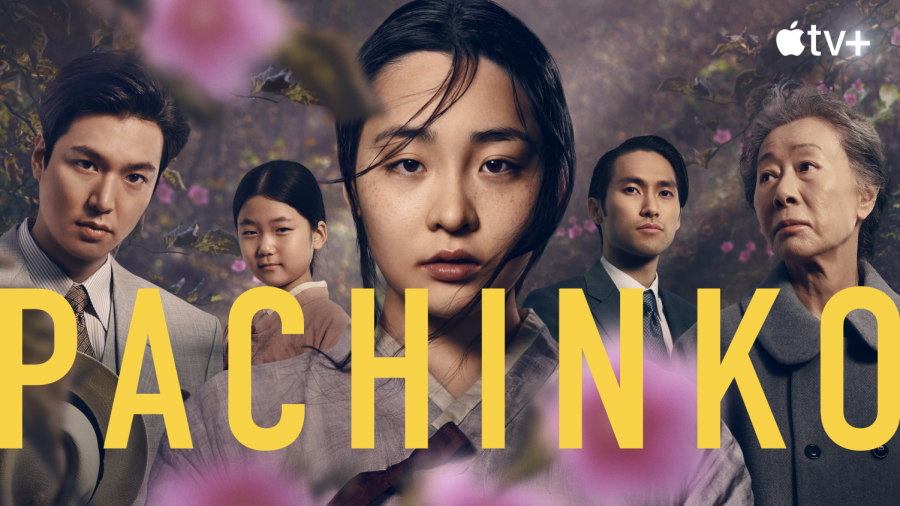‘Pachinko’: Revealing History Through the Lens of a Korean Family
Apple TV+’s recently aired series touches the hearts of Koreans everywhere
APPLE TV+
Pachinko, a new release on Apple TV+, explores the life of a Korean family living in Japan.
April 19, 2022
“In 1910, Japan colonized Korea as part of its growing empire. Under Japanese rule, many Koreans lost their livelihood, forcing many to leave their homes for foreign lands. Despite this, the People endured. Families endured. Including one family … From one generation to another.”
These are the first words that appear on the screen at the start of Apple TV+’s new series, “Pachinko.”
The story follows, explaining that when the Empire of Japan colonized Korea, Japanese assimilation policies were implemented, resulting in a detachment from traditional Korean culture. Koreans saw their language, religion, and agricultural industry were taken away by the Japanese. They were forced to take Japanese names. Hundreds of thousands of Koreans even migrated to Japan.
“Pachinko” tells a fascinating story of colonialism and diasporic nationalism, war and peace, love and loss, and victory and sorrow.
You’re probably wondering what the message of this great historical drama is.
Does it teach the contemporary generation about history? Or does it generate nostalgia in particular viewers, such as Korean or Japanese people, by forcing them to look back and consider the linkages that connect the present to the past?
Without a shadow of a doubt, I’m glad to declare that “Pachinko” does all of that, if not more.
Based on the novel of the same name by Korean American, Manhattan-based novelist Min Jin Lee, “Pachinko” is a sweeping historical drama about one family’s experience living as “foreign residents” in 20th-century Japan.
“Pachinko” tells a fascinating story of colonialism and diasporic nationalism, war and peace, love and loss, and victory and sorrow, exclusively from a metahistorical human perspective.
Pachinko is a game of chance and survival, both figuratively and literally.
Episode Highlights
The opening was the highlight of the TV series. When one looks at the opening credits, it is unclear whether this is a Korean, Japanese or Westernized drama. The main cast members gathered in a vividly colored pachinko parlor as if it were a paradise.
Pachinko are popular gambling machines in Japan; what people don’t know is that most of the pachinko parlors were owned by Koreans as their main form of business when they migrated to Japan. It is not a coincidence for “Pachinko” to be the title of the series and the main setting for the show’s opening.
To Koreans who sacrificed everything to come to Japan, pachinko is a game of chance and survival, both figuratively and literally.
In contrast to the book, which is ordered chronologically from the 1930s to the late 1980s, the filmmakers of this series made a bold change. The nonlinear construction of time in the series jumps between past and present: early 1900s Korea and 1980s Japan.
The show starts in the mid-1910s when Japan’s invasion of Korea reduced the country to dire poverty.
A fisherman and his wife have a daughter named Sunja (Kim Min-ha), the main character of the story, in the southern coastal city of Busan. Sunja is a complex and passionate character — she may be seen as innocent and naive, but deep down, she is a strong, stubborn woman and devoted mother and grandmother shaken by the moral crisis. Never finding true happiness and peace throughout her life, Sunja continues to survive and thrive against the indifferent arc of history and do what’s best for her loved ones.
As time progresses, Sunja’s journey begins to slowly unravel, but not in the way you’d expect.
A teenager Sunja engages in a love affair with Koh Hansu (Lee Min-ho), a rich merchant and fish broker. Initially seen as a romantic experience, it comes with the burden of pregnancy, the harsh truth about Hansu and social ostracization. Ashamed of her actions, she cuts all ties with him but decides to remain pregnant with the child.
Solomon is the product of a clash of different countries tied to historical animosity.
When all hope is lost, she encounters Baek Isak (Steve Sang-Hyun Noh), a Christian priest from Pyongyang, who was willing to be a father to Sunja’s child and take her to Osaka.
That narrative then shifts to the future with the introduction of Solomon Baek (Jin Ha), which is set in 1989. The grandson of an older Sunja (Youn Yuh-jung), Solomon is what the Japanese would call a “Zainichi,” a term that means “to stay in Japan” but is usually used as shorthand for Koreans who came to and permanently stayed in Japan, including their Japan-born descendants.
The Japanese government considered Koreans as foreign residents based on ethnicity. It did not matter whether you were born and raised in Japan — if you have Korean heritage, you are Korean in the eyes of the Japanese people. Even today, they still face systemic discrimination in Japan.
Born and raised in Japan, educated in America, working at an American bank and speaking three languages — English, Japanese and Korean — Solomon is the product of a clash of different countries tied to historical animosity.
Looking for a promotion, he suggests to his bosses that he can convince a Korean woman, whose house is standing in the way of a Japanese client’s plans for a hotel, to sell. Thus, he traveled to Osaka, his hometown, eventually reconnecting with his family. From that point, he constantly finds himself unsure of who he is — is he Korean, Japanese or something else?
An Important Message
“Pachinko” offers us a reality check on the assumption that the age of globalization may make life easier. It suggests that globalization can also push us further away from our roots and ancestors.
This story is truly extraordinary and unique, and one that should not be viewed as a typical migration story from a Western perspective.
In “Pachinko,” identity is not defined in terms of binary codes: Korean or Japanese. Each story is different, and each individual is different in spite of their shared historical experience.
Growing up as an American who has to fully get in touch with my heritage, I understood why heritage is important the more I watched the series.
The recounting of Sunja’s journey specifically feels nostalgic yet melancholic as it serves as a reminder of the wartime and post-war stories of first-generation Koreans and onward.
However, the subtext of these memories forces us to understand what they had actually gone through in the course of history and how it affects the current Zainichi Korean generation.
As an American-born student of half-Japanese and half-Iranian descent, I am moved by “Pachinko’s” message. I am reminded of what it means to preserve our legacy because it is a part of our history, distinctive and nostalgic. Growing up as an American who has to fully get in touch with my heritage, I understood why heritage is important the more I watched the series.
It is the treasure our parents want us to learn about and pass on to future generations. It is the link between the past and the future, something that encourages us to consider who we are, how our histories cross and define us, what our parents sacrificed and did for us and who we will become in the future with this knowledge.
And most importantly, it shows us how resilient and strong people can be despite what life throws at them.
















Dinesh • Mar 9, 2024 at 5:01 pm
Pachinko stresses on preserving our grassrooots. When you move to work and settle in another country then they say that the birthland is the
Motherland “Janambhoomi” and the new new country is the “Karambhoomi” the work place.